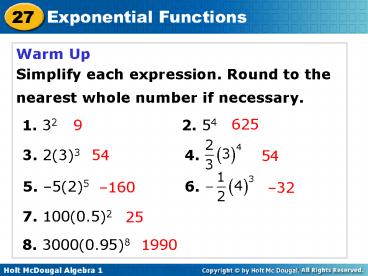Warm Up PowerPoint PPT Presentation
1 / 16
Title: Warm Up
1
Warm Up Simplify each expression. Round to the
nearest whole number if necessary.
625
1. 32
2. 54
9
3. 2(3)3
4.
54
54
5. 5(2)5
6.
160
32
7. 100(0.5)2
25
8. 3000(0.95)8
1990
2
Objectives
Identify and graph exponential functions.
3
The table and the graph show an insect population
that increases over time.
4
A function rule that describes the pattern above
is f(x) 2(3)x. This type of function, in which
the independent variable appears in an exponent,
is an exponential function. Notice that 2 is the
starting population and 3 is the amount by which
the population is multiplied each day.
5
Example 1 Evaluating an Exponential Function
The function f(x) 500(1.035)x models the amount
of money in a certificate of deposit after x
years. How much money will there be in 6 years?
f(x) 500(1.035)x
Write the function.
Substitute 6 for x.
f(6) 500(1.035)6
Evaluate 1.0356.
500(1.229)
614.63
Multiply.
There will be 614.63 in 6 years.
6
Remember that linear functions have constant
first differences and quadratic functions have
constant second differences. Exponential
functions do not have constant differences, but
they do have constant ratios.
As the x-values increase by a constant amount,
the y-values are multiplied by a constant amount.
This amount is the constant ratio and is the
value of b in f(x) abx.
7
Example 2 Identifying an Exponential Function
Is this an exponential function? Why?
(0, 4), (1, 12), (2, 36), (3, 108)
This is an exponential function. As the x-values
increase by a constant amount, the y-values are
multiplied by a constant amount.
x y
0 4
1 12
2 36
3 108
8
Example 3 Identifying an Exponential Function
Is this an exponential function? Why?
(1, 64), (0, 0), (1, 64), (2, 128)
x y
1 64
0 0
1 64
2 128
This is not an exponential function. As the
x-values increase by a constant amount, the
y-values are not multiplied by a constant amount.
9
Example 4 Graphing y abx with a gt 0 and b gt 1
Graph y 0.5(2)x
Choose several values of x and generate ordered
pairs.
Graph the ordered pairs and connect with a smooth
curve.
x y 0.5(2)x
1 0.25
0 0.5
1 1
2 2
10
Example 5 Graphing y abx with a lt 0 and b gt 1
Graph the ordered pairs and connect with a smooth
curve.
Choose several values of x and generate ordered
pairs.
x
1 0.125
0 0.25
1 0.5
2 1
11
The box summarizes the general shapes of
exponential function graphs.
Graphs of Exponential Functions
a gt 0
a gt 0
a lt 0
a lt 0
For y abx, if b gt 1, then the graph will have
one of these shapes.
For y abx, if 0 lt b lt 1, then the graph will
have one of these shapes.
12
Example 6 Application
In 2000, each person in India consumed an average
of 13 kg of sugar. Sugar consumption in India is
projected to increase by 3.6 per year. At this
growth rate the function f(x) 13(1.036)x gives
the average yearly amount of sugar, in kilograms,
consumed per person x years after 2000. Using
this model, in about what year will sugar
consumption average about 18 kg per person?
13
Example 6 Continued
Enter the function into the Y editor of a
graphing calculator.
The average consumption will reach 18kg in 2009.
14
Lesson Quiz Part I
Tell whether each set of ordered pairs satisfies
an exponential function. Explain your answer.
1. (0, 0), (1, 2), (2, 16), (3, 54)
No for a constant change in x, y is not
multiplied by the same value.
2. (0,5), (1, 2.5), (2, 1.25), (3, 0.625)
Yes for a constant change in x, y is multiplied
by the same value.
15
Lesson Quiz Part II
3. Graph y 0.5(3)x.
16
Lesson Quiz Part III
4. The function y 11.6(1.009)x models
residential energy consumption in quadrillion Btu
where x is the number of years after 2003. What
will residential energy consumption be in 2013?
? 12.7 quadrillion Btu
5. In 2000, the population of Texas was about 21
million, and it was growing by about 2 per year.
At this growth rate, the function f(x)
21(1.02)x gives the population, in millions, x
years after 2000. Using this model, in about what
year will the population reach 30 million?
2018

